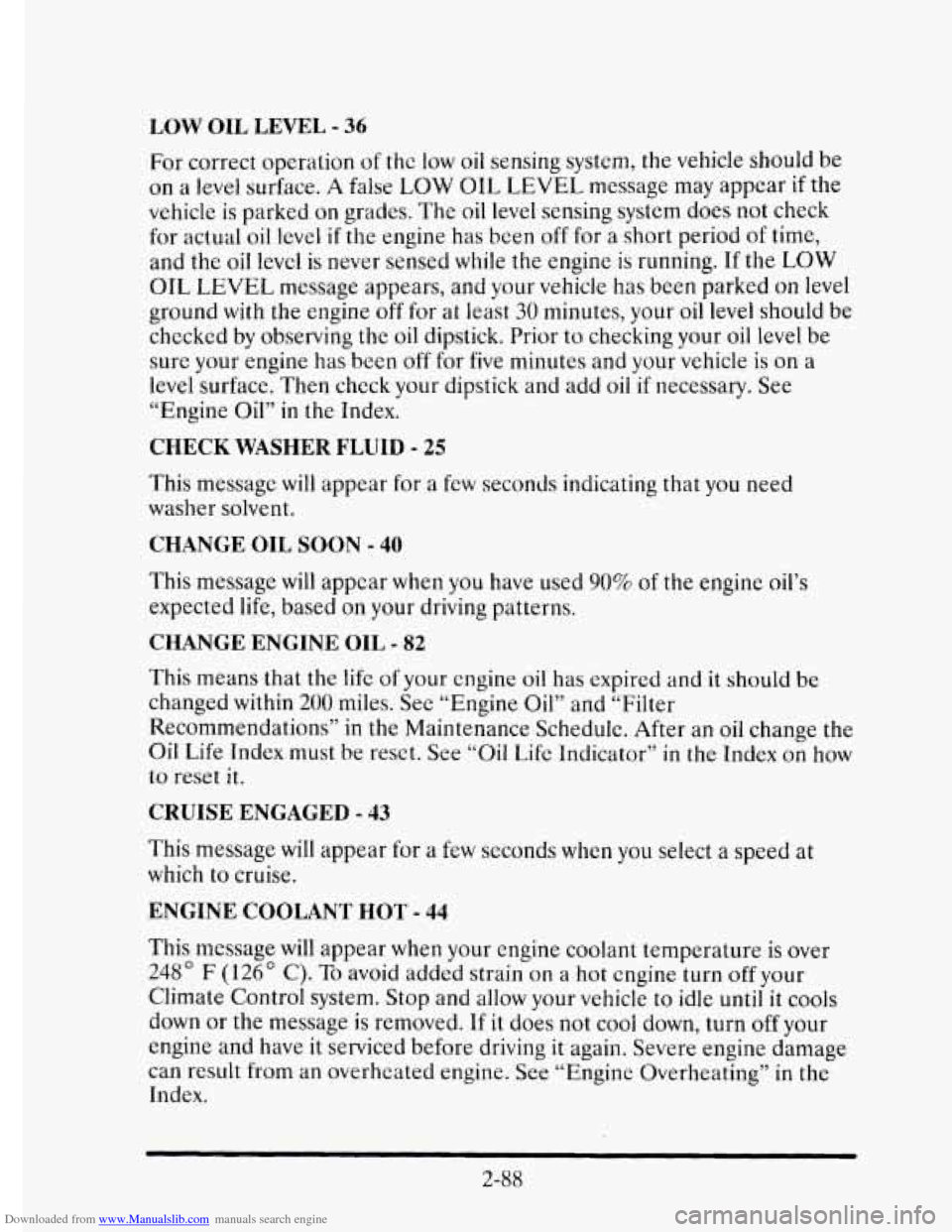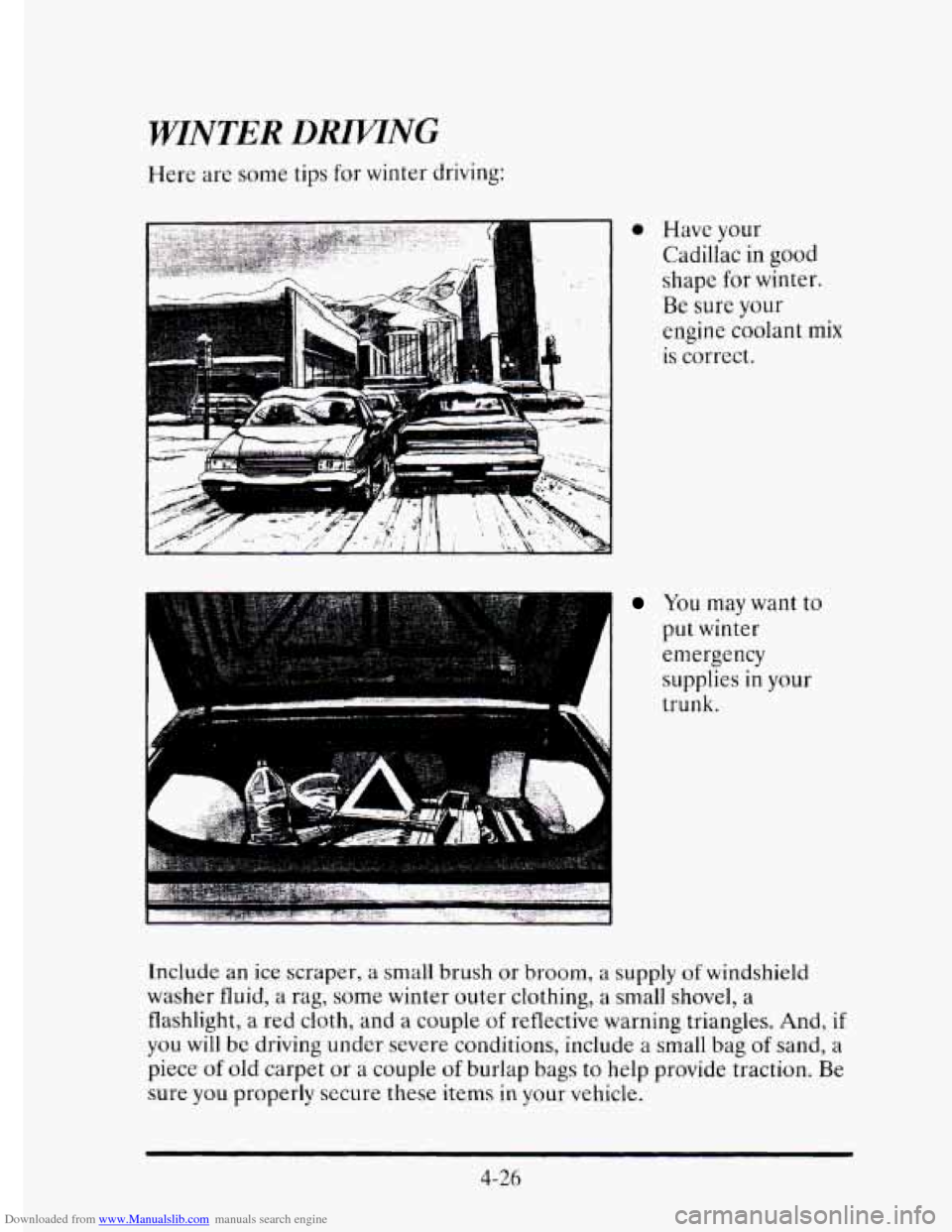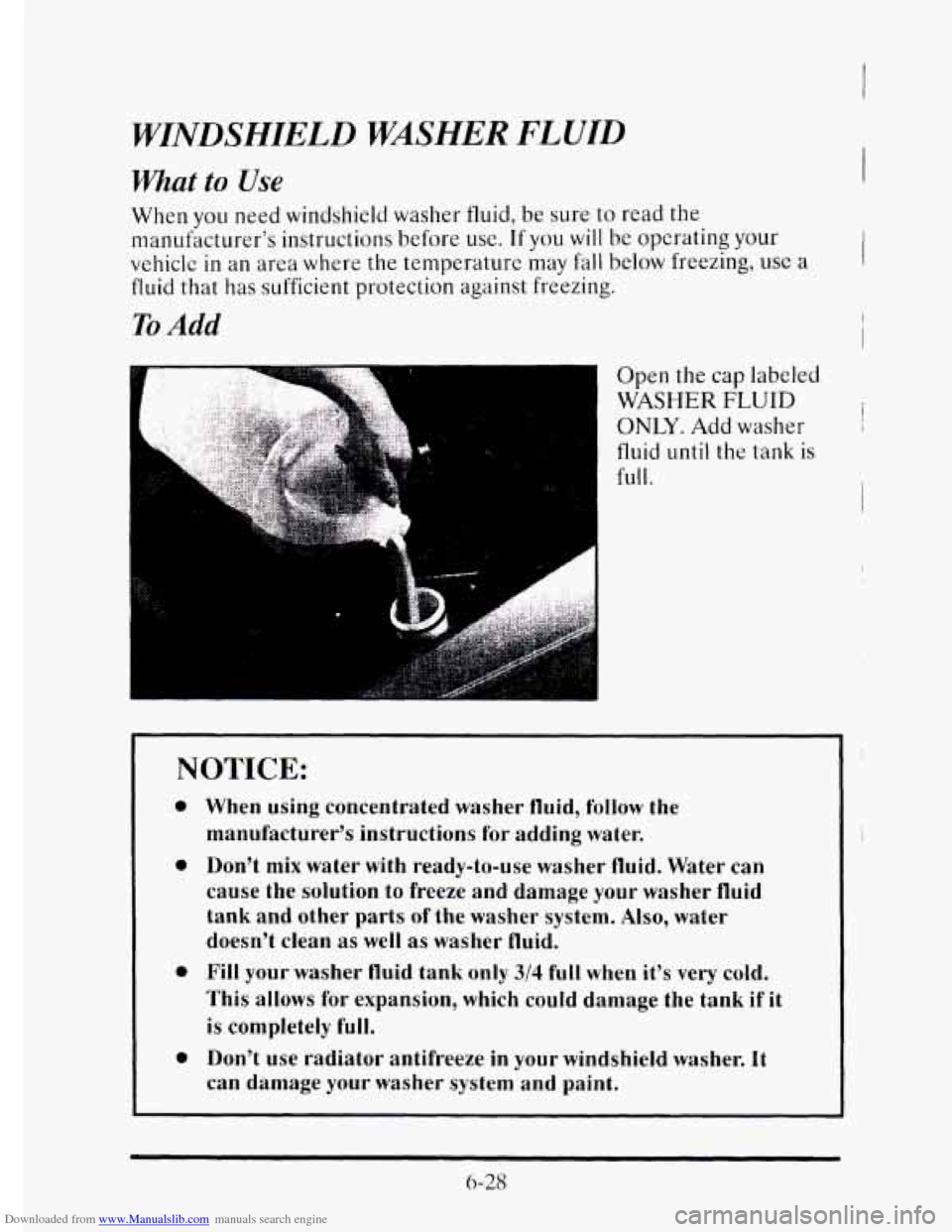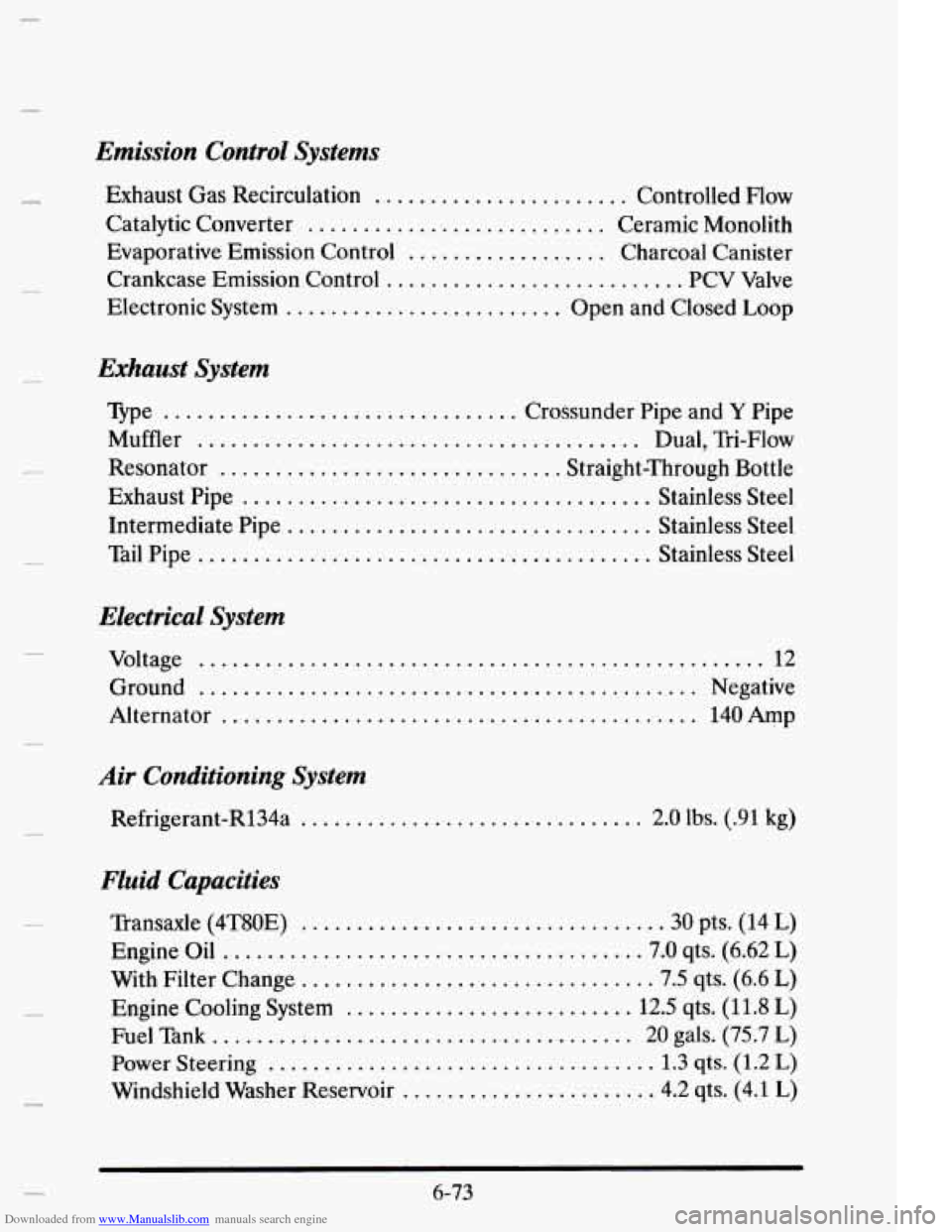1995 CADILLAC ELDORADO washer fluid
[x] Cancel search: washer fluidPage 113 of 395

Downloaded from www.Manualslib.com manuals search engine OFF To turn the wipers off, turn the band to OFF.
Damaged wiper blades may prevent you from seeing well enough to drive
safely.
To avoid damage, be sure to clean ice and snow from the wiper
blades before
using them. If they're frozen to the windshield, carefully
loosen or thaw them.
If your blades do become damaged, get new blades
or blade inserts.
Heavy snow or ice can overload
your wiper motor. A circuit breaker will stop
the motor until it cools. Clear away snow or ice to prevent an overload.
Windshield Washer
I A d
To wash your
windshield, press
and
hold the paddle labeled
PUSH. Once you feel
you have enough
washer fluid on the
windshield, release the
paddle. The wipers will
continue to clear the
windshield, then either
stop or return to your
preset speed.
When the washer fluid reaches a low level, LOW WASHER
FLUID will
be displayed in the Driver Information Center.
Driving without washer
fluid can be dangerous. A bad mud splash can
block your vision and you could hit another vehicle or
go off the road.
Check your washer fluid level often.
A CAUTION:
In freezing weather, don't use your washer until the windshield
is warmed. Otherwise the washer fluid can form ice on the
windshield, blocking your vision.
2-42
Page 114 of 395

Downloaded from www.Manualslib.com manuals search engine NOTICE:
e When using concentrated washer fluid, follow the
manufacturer’s instructions for adding water.
e Don’t mix water with ready-to-use washer fluid. Water can
cause the solution to freeze and damage your washer fluid
tank and other parts
of the washer system. Also, water
doesn’t clean
as well as washer fluid.
I e Fill your washer fluid tank only 3/4 full when it’s very cold.
This allows
for expansion, which could damage the tank if it
is completely full.
Don’t use radiator antifreeze in your windshield washer. It
can damage your washer system and paint.
Headlamp Washer (Export Only)
If you have this feature, you will wash your headlamps while washing your
windshield at the same time. Just press the
PUSH paddle on the
multifunction lever.
2-43
Page 159 of 395

Downloaded from www.Manualslib.com manuals search engine LOW OIL LEVEL - 36
For correct operation of the low oil sensing system, the vehicle should be
on a level surface. A false LOW OIL LEVEL message may appear if the
vehicle is parked
on grades. The oil level sensing system does not check
for actual oil
level if the engine has been off for a short period of time,
and the
oil level is never sensed while the engine is running. If the LOW
OIL LEVEL message appears, and your vehicle has been parked on level
ground with
the engine off for at least 30 minutes, your oil level should be
checked by observing the oil dipstick. Prior to checking your oil level be
sure your engine has
been off for five minutes and your vehicle is on a
level surface. Then check your dipstick and add oil if necessary. See
“Engine
Oil” in the Index.
CHECK WASHER FLUID - 25
This message will appear for a few seconds indicating that you need
washer solvent.
CHANGE OIL SOON - 40
This message will appear when you have used 90% of the engine oil’s
expected life, based on your driving patterns.
CHANGE ENGINE OIL - 82
This means that the life of your engine oil has expired and it should be
changed within 200 miles. See “Engine Oil” and “Filter
Recommendations”
in the Maintenance Schedule. After an oil change the
Oil Life Index must be resct. See “Oil Life Indicator” in the Index on how
to reset it.
CRUISE ENGAGED - 43
This message will appear for a few seconds when you select a speed at
which to cruise.
ENGINE COOLANT HOT - 44
This message will appear when your engine coolant temperature is over
248’ F (126’ C). To avoid added strain on a hot cngine turn off your
Climate Control system. Stop and allow your vehicle
to idle until it cools
down or the message is removed.
If it does not cool down, turn off your
engine and have it serviced before driving
it again. Severe engine damage
can result from an overheated engine. See “Engine Overheating” in the
Index.
2-88
Page 213 of 395

Downloaded from www.Manualslib.com manuals search engine WINTER DRIVTNG
Here are some tips for winter driving:
0 Have your
Cadillac in
good
shape for winter.
Be sure your
engine coolant mix
is correct.
You may want to
put winter
emergency
supplies in your
trunk.
Include an ice scraper,
a small brush or broom, a supply of windshield
washer fluid, a rag, some winter outer clothing, a small shovel,
a
flashlight, a red cloth, and a couple of reflective warning triangles. And, if
you will be driving under severe conditions, include a small bag of sand, a
piece of old carpet or a couple of burlap bags to help provide traction. Be
sure you properly secure these items in your vehicle.
4-26
Page 268 of 395

Downloaded from www.Manualslib.com manuals search engine Fluid Usage Label
LI
Then go to the front of
the vehicle and lift the
secondary hood release
to open the hood.
The fluid usage label is a color coded label identifying the various fluids
used in your vehicle.
Colors represented on the label match the lettering or handle color
of the
fluid you want
to check.
0 GREEN: Engine Coolant
ORANGE: Power Steering Fluid
0 YELLOW: Engine Oil
0 RED: Transmission Fluid
0 WHITE: Brake Fluid
BLUE: Washer Fluid
6-9
Page 287 of 395

Downloaded from www.Manualslib.com manuals search engine WINDSHIELD WASHER FLUID
What to Use
When you need windshield washer fluid, be sure to read the
manufacturer’s instructions before
use. If you will be operating your
vehicle
in an area where the temperature may fall below freezing, use a
fluid that has sufficient protection against freezing.
To Add I
Open the cap labeled
WASHER FLUID
ONLY. Add washer
fluid until the tank is
full.
NOTICE:
0
0
0
0
When using concentrated washer fluid, follow the
manufacturer’s instructions for adding water.
Don’t mix water with ready-to-use washer fluid. Water can
cause the solution to freeze and damage your washer fluid
tank and other parts of the washer system.
Also, water
doesn’t clean
as well as washer fluid.
Fill your washer fluid tank only 3/4 full when it’s very cold.
This allows
for expansion, which could damage the tank if it
is completely full.
Don’t use radiator antifreeze in your windshield washer. It
can damage your washer system and paint.
6-28
Page 332 of 395

Downloaded from www.Manualslib.com manuals search engine Emission Control Systems
Exhaust Gas Recirculation ....................... Controlled Flow
Catalytic Converter
........................... Ceramic Monolith
Evaporative Emission Control
.................. Charcoal Canister
Crankcase Emission Control
........................... PCV Valve
Electronic System
......................... Open and Closed Loop
Exhaust System
Type ................................ Crossunder Pipe and Y Pipe
Muffler
........................................ Dual, Tri-Flow
Resonator
............................... Straight-Through Bottle
Exhaust Pipe
..................................... Stainless Steel
Intermediate Pipe
................................. Stainless Steel
Tail Pipe
......................................... Stainless Steel
Electrical System
Voltage ................................................... 12
Alternator
........................................... 140Amp
Ground
............................................. Negative
Air
Conditioning System
Refrigerant-R134a ............................... 2.0 lbs. (.91 kg)
Fluid Capacities
Transaxle (4T80E) ................................ .30 pts. (14 L)
Engine Oil ...................................... 7.0 qts. (6.62 L)
With Filter Change ................................ 7.5 qts. (6.6 L)
Engine Cooling System .......................... 12.5 qts. (1 1.8 L)
Fuel Tank ...................................... 20 gals. (75.7 L)
Power Steering ................................... 1.3 qts. (1.2 L)
Windshield Washer Reservoir ....................... 4.2 qts. (4.1 L)
6-73
Page 380 of 395

Downloaded from www.Manualslib.com manuals search engine C
.
.
.
.
.
c
.
.
.
.
Capacities and Specifications ......................... 6-71
Carbon Monoxide ......................... 2.34.4.29. 4.36
Cassette Tape Player Care ........................... 3-20
Center Console .................................... 2-13
Center High Mounted Stop Lamp Bulb Replacement .... 6-40
Center Passenger Position ........................... 1-35
Certificationmire Label ............................. 4-31
Chains. Safety ..................................... 4-36
Chains. Tire ....................................... 6-50
Change Engine Oil Message ......................... 2-88
Change Oil Soon Message ........................... 2-88
Change Trans Fluid Message ......................... 2-87
Changing a Flat Tire ................................ 5-22
Check Brake Fluid Message .......................... 2-87
Check Coolant Level Message ........................ 2-87
Check Fuel Gage Message ........................... 2-87
Check Washer Fluid Message ................... 2.88, 2.89
Checking
Automatic Transaxle Fluid
........................ 6-19
Brake Fluid ..................................... 6-30
Engine Coolant ................................. 6-25
Engineoil ...................................... 6-11
Power Steering Fluid ............................. 6-26
Restraint Systems ................................ 1-51
Things Under the Hood ........................... 6-8
Chemical Paint Spotting ............................. 6-59
Child Restraints .................................... 1-38
Securing in a Rear Outside Seat Position ............ 1-41
Securing in the Center Rear Seat Position ........... 1-42
Securing in the Right Front Seat Position ............ 1-45
Top Strap ....................................... 1-40
Where to Put ................................... 1-39
Cigarette Lighter ................................... 2-68
Circuit Breaker. Power Windows and Other Power Options 6-69
Cleaner, Air ....................................... 6-16
Cleaning
Aluminum Wheels
............................... 6-58
Fabric .......................................... 6-52
Glass .......................................... 6-56
Leather ........................................ 6-54
Outside of the Windshield and Wiper Blades ......... 6-56
Speaker Covers .................................. 6-55
Special Problems ................................ 6-53
Stains ........................................... 6-52
.
.